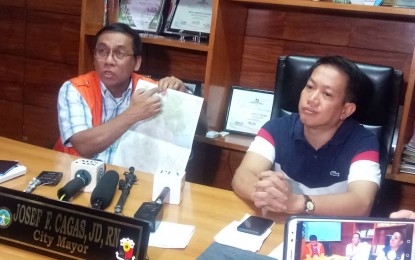
NOT MAN-MADE. Undersecretary Renato Solidum of Phivolcs say the strong earthquakes that hit Davao del Sur and North Cotabato were neither man-made nor volcanic in origin. Digos City Mayor Josef Cagas (in blue polo) listens. (PNA photo by Eldie Aguirre)
DIGOS CITY, Davao del Sur – Science and Technology Undersecretary Renato Solidum had shot down speculations that the strong earthquakes that have hit North Cotabato and Davao del Sur were possibly human-induced.
Although he did not refer to any human activity, social media websites, particularly Facebook, had been rife with suspicions that the quakes, including the magnitude 6.9 tremor that hit Padada town on December 15, 2019, were possibly man-made.
Social media users have been sharing links to online articles about the High-Frequency Active Auroral Research Program (H.A.A.R.P), which is an ionospheric research program jointly funded by various US agencies and was started in 1993.
Some articles, mainly from obscure websites, claimed that the H.A.A.R.P can generate strong earthquakes that could devastate areas the US would target.
However, Solidum, also the officer in charge of the Philippine Institute of Volcanology and Seismology (Phivolcs), said during an interview with reporters at the office of Mayor Josef Cagas here that there is no known man-made activity that can generate such powerful quakes as the ones that hit the province and nearby North Cotabato.
“Why? The origins of the quakes are three kilometers below ground or more. There is no human activity that can reach that deep,” he added.
Solidum also said that contrary to other suspicions, the quakes had nothing to do with Mt. Apo, which straddles the two provinces.
“Those are not related to Mt. Apo. Can it affect Mt. Apo and trigger an explosion? Well, Mt. Apo is a potentially active volcano but if the quakes had affected it, we would have seen the signs already because of the consecutive strong tremors. These include volcanic quakes, the heated ground near the volcano, wilted vegetation, magma, and even smoke. There is none of these,” he said in Filipino.
He said Phivolcs should be the first one to know if Mt. Apo becomes restive.
“We have sensors around Mt. Apo,” he added.
Solidum said by all indications, the October quakes, and Sunday's tremor were caused by several active fault lines traversing areas of North Cotabato and Davao del Sur.
He made assurances that Phivolcs was continuing its monitoring of the faults by installing seismic stations in various areas of the two provinces. (PNA)
